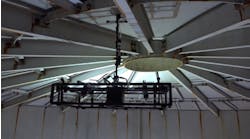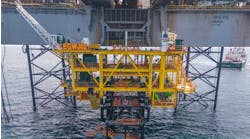Bruce Beaubouef • Houston
At this year's Offshore Technology Conference in Houston, Bureau of Safety and Environmental Enforcement Director James A. Watson discussed recent recruitment incentives, BSEE's offshore safety focus, and regulatory priorities. His remarks offered insight into the government's actions in the two years following the Macondo oil spill, as well as its plans for offshore safety regulations going forward.
He noted that two major rules had been issued late in 2010 in reaction to theDeepwater Horizon. One, the Drilling Safety Rule, was issued as an emergency rule. It implemented higher standards for well design, casing and cementing practices, and blowout preventers, among other new safety requirements. The Workplace Safety Rule puts in place for the first time performance-based standards, requiring companies to implement and maintain Safety and Environmental Management System (SEMS) programs.
Watson said that he was pleased to hear reports that the number of rigs coming into the Gulf continues to increase, and added that "it is in our nation's interest to have a robust offshore oil and gas industry." But he said that he was equally cautious about the potential for this increased activity to increase the risks associated with offshore drilling.
He recognized that "a lot of attention has been focused on the number of permits we have issued since theDeepwater Horizon." Still others have focused on the number of Incidents of Noncompliance, or INCs, issued in that same time. While both were important metrics, he said that he did not believe the goal of BSEE should be to approve "a certain number of permits or issue a certain number of INCs."
Rather, he argued that the agency must use its full suite of authorities and resources, employing both prescriptive and performance-based standards to instill safe practices at all levels, at all times. He recognized that the agency must maintain a dialogue with the industry to help companies understand "our requirements for those applications." He said that these requirements included inspections drills, transparency in policies, and consistency in action.
Watson noted that one of BSEE's responsibilities is to issue clearly defined, meaningful regulations. In the immediate aftermath of theDeepwater Horizon, he said that the bureau issued new requirements that addressed critical weaknesses and allowed drilling activities to resume, while providing confidence that those activities could be conducted safely.
"Since that time," he acknowledged, "there has been a great deal of anticipation about the next generation of regulations that would further enhance safety and environmental protection, based upon the lessons learned from the blowout and spill." He noted that, based on reports from the President's Oil Spill Commission, the National Academy of Engineering, and a BSEE/US Coast Guard investigation, the agency identified substantive recommendations that needed to be addressed "sooner rather than later." Thus, the agency's regulatory focus for the year will include four key items: 1) completing the Final Drilling Safety Rule; 2) completing the SEMS 2 rule, which further enhances the existing Workplace Safety Rule; 3) preparing a proposed rule to enhance the requirements for blowout preventers (BOPs); and 4) preparing a proposed rule on Production Safety Systems and Lifecycle Analysis.
The Drilling Safety Rule was published on Oct. 14, 2010, as an interim final, or under emergency rulemaking. Watson noted that the agency is completing revisions to that rule based on a number of comments received requesting additional clarifications or appropriate modifications that would not affect safety. He also noted that "should to must" language issue will be addressed as part of this process.
The Workplace Safety Rule went into full effect last November, and now companies are required to have an SEMS program in place. In September of last year, the agency published a rule that included refinements and an expansion of the SEMS program, colloquially known as SEMS 2. This rule includes additional provisions involving stop-work authority, requirements for reporting unsafe working conditions, requirements for employees to participate in the development and implementation of the SEMS program, and requirements for the use of independent third parties to perform SEMS audits. The final rule will also include training and performance criteria for audits and auditors.
Watson noted that those previous two items were extensions of existing rules, but added that the agency is also working on new safety standards, including one related to the design, manufacture, and repair of BOPs. The Drilling Safety Rule contained a number of provisions related to blowout preventers, but the various investigations on theDeepwater Horizon, in particular the ones from the National Academy of Engineers and the BSEE/US Coast Guard Joint Investigation Team, highlighted a number of additional issues with BOPs – "arguably the most critical piece of safety and well control equipment on a rig" – that need to be addressed, Watson observed.
"This is a rule that I believe is much needed, and we will work deliberately toward getting a draft rule published," said Watson. "This is an area where we will need active involvement from both those in the industry as well as other stakeholder organizations as we work on crafting this proposal." He announced that on May 22, in Washington, D.C., the BSEE had scheduled an all-day public forum to discuss BOPs and "how we can continue to improve their reliability and safety." He noted that the agency invited experts from around the country to participate in panel discussions for an "open and candid dialogue."
Finally, he said that the BSEE also is working on a draft rule to update oil and gas production safety systems regulations. "These regulations have not had a major revision since 1988," Watson observed. "Since that time, production has moved into deeper and deeper water, and regulations have simply not kept pace with technological advances." He noted that this rulemaking would address recommendations resulting from the agency's recent investigation on the BP Atlantis platform, and that it will propose an expanded use of lifecycle analysis of critical equipment to increase equipment reliability. Watson said that this would be a performance-based system that includes design verification, quality assurance requirements, a failure reporting process to identify quality of design defects, repair and maintenance requirements, and certification of equipment and personnel. "These revisions will provide BSEE a powerful regulatory tool that can be used in the future to incorporate new technologies into the program," he said.
The entire transcript of Director Watson's comments can be read at:bsee-director-outlines.html
Offshore Articles Archives
View Oil and Gas Articles on PennEnergy.com


